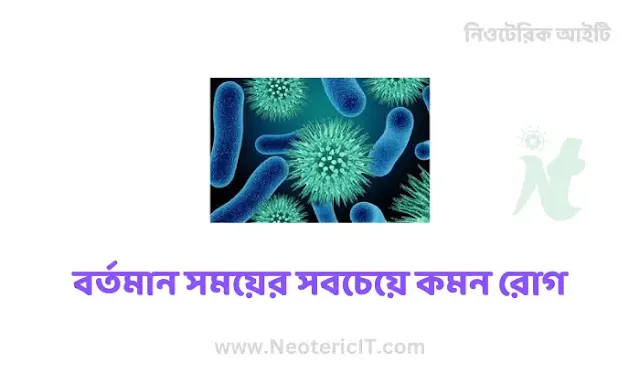The most known and common diseases of the present time
Hello dear guest - Welcome to Neoteric IT . You have come to Neoteric IT for information about The most known and common diseases of the present time Today I will conclude this article by discussing The most known and common diseases of the present time in detail. Search Google to know more about The most known and common diseases of the present time write The most known and common diseases of the present time or click here insightflowblog.com for visit. See the page Table of content for know the main topic of this article. Web story and AMP Version
The number of diseases has increased day by day. In this episode of Neoteric IT, we will talk about all the common diseases that people have one or the other disease. If you know the symptoms of the disease through this episode, you can recognize the disease and take action accordingly.
Most Common Diseases - NeotericIT.com
Cardiovascular Disease:
Cardiovascular disease is a group of conditions that affect the heart and blood vessels. The most common types of cardiovascular disease include heart attack, stroke and hypertension (high blood pressure). These conditions are caused by plaque build-up in blood vessels, which can lead to blockages and restrict blood flow to the heart and brain. Symptoms of cardiovascular disease may include chest pain or discomfort, shortness of breath, fatigue, and light-headedness.
Cancer:
Cancer is a disease characterized by uncontrolled growth and proliferation of abnormal cells in the body. There are different types of cancer including lung cancer, breast cancer, prostate cancer and colorectal cancer. Cancer symptoms can vary depending on the type and stage of the disease but can include fatigue, pain, skin changes and unexplained weight loss.
Diabetes:
Diabetes is a chronic condition in which the body is unable to properly use and store glucose (a type of sugar). There are two main types of diabetes: type 1 diabetes, which is an autoimmune disorder, and type 2 diabetes, which is caused by a combination of genetic and lifestyle factors. Symptoms of diabetes can include increased thirst, frequent urination, blurred vision, and fatigue.
Respiratory Diseases:
Respiratory diseases, such as asthma and chronic obstructive pulmonary disease (COPD), affect the lungs and airways. Asthma is a chronic inflammatory disorder of the airways that can cause shortness of breath, wheezing, and chest tightness. COPD is a progressive disorder that makes it difficult to breathe and is usually caused by smoking. Symptoms of respiratory disease may include coughing, shortness of breath, and shortness of breath.
Digestive Diseases:
Digestive disorders, such as irritable bowel syndrome (IBS) and inflammatory bowel disease (IBD), affect the gastrointestinal tract. IBS is a common condition that affects the large intestine and can cause symptoms such as abdominal pain, diarrhea and constipation. IBD is a group of inflammatory conditions that affect the digestive system and can cause similar symptoms as well as weight loss, fatigue and fever.
Types of Digestive Diseases and Symptoms
Muscle Disorders:
Musculoskeletal disorders such as osteoarthritis and rheumatoid arthritis affect the bones, joints and muscles. Osteoarthritis is a degenerative condition that wears down joint cartilage, causing pain and stiffness. Rheumatoid arthritis is an autoimmune disorder that causes inflammation of the joints, resulting in pain, stiffness and decreased range of motion.
Neurological disorders:
Neurological disorders, such as Alzheimer's disease and Parkinson's disease, affect the brain and nervous system. Alzheimer's disease is a progressive disorder that causes memory loss, confusion, and difficulty with daily activities. Parkinson's disease is a neurodegenerative disorder that causes tremors, rigidity, and movement difficulties.
Mental health disorders:
Mental health disorders, such as depression and anxiety, affect a person's emotions and behavior. Depression is a mental disorder characterized by feelings of sadness or hopelessness, difficulty concentrating, and loss of interest in activities. Anxiety is a feeling of fear, nervousness, or worry that is often accompanied by physical symptoms such as a rapid heartbeat and sweating.
Infectious Diseases:
Infectious diseases, such as influenza and COVID-19, are caused by microorganisms such as viruses and bacteria. Influenza, commonly known as the flu, is a respiratory infection that can cause fever, cough, and difficulty breathing. COVID-19 is a highly contagious respiratory illness caused by SARS-Co
Thanks for read the post. You can also read the article in bangla - most-common-diseases
You are indeed a valued reader of Neoteric IT. Thank you so much for reading The most known and common diseases of the present time article. Please let us know how you feel after reading this article.

 Follow Google News to get the latest Neoteric IT news
Follow Google News to get the latest Neoteric IT news 
.png)





Please comment in accordance with the policy - otherwise your comments will not be accepted.
comment url